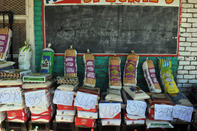Links Between Poverty and Food Insecurity
What determines a household's ability to access food?

The factors comprise a vast and overlapping network of forces: whether they have money to buy food, be it from a job, a social grant or, quite literally, from begging, borrowing or stealing; where a community is relative to the nearest shops and health services, and how those distances impact on the cost of food (supermarket food is often cheaper than spaza shop food, but the distances between poorer communities and commercial hubs add additional transport costs to the price of a basket of food).
Whether they have water and electricity in their homes to keep the food sanitary, or if they are living in a shack and are less able to store food safely; what social networks they can plug into in order to get support when the cupboards run low.
Because there is such a strong link between poverty and food insecurity, and given the importance of having money when you are plugged into the grid of the cash economy, what happens at an inflationary level has serious implications for a family's domestic food security.
The Impact of Rising Food Prices
The cost of food has risen sharply since 2006, with a spike in 2008 that has not really eased off. Between 2007 and 2008, the cost of some of the main crops went up dramatically on global markets: wheat by 130%, soya by 87%, rice by 74% and maize by 31%.
In South Africa, the trend in food price increases has continued. In the year from October 2010 to October 2011, the cost of super and special maize meal rose by 30%, white maize by 73%, while the cost of white and brown bread rose by nearly 13%.
These inevitably impact on the price of a basic basket of food in a supermarket. But where the price tag on agricultural yields is relatively elastic, jumping up and down monthly or seasonally depending on myriad factors (the cost of inputs and oil prices, shortages or oversupplies, global trading, exchange rates and the like), prices at a supermarket level are more 'sticky'.
The trend at the consumer level is for continued upward pricing with little downward adjustment, even if prices are dropping at the agricultural end of the value chain. To understand the implications for the shopper, let us first take a look at how people choose to spend their money.
According to Statistics South Africa, families spend most of their household budgets on keeping a roof over their heads (just under 25% of the budget goes on housing, electricity, gas and other fuels); next is the cost of transport (20% of the budget); then food (just under 15% of the budget).
But when you look at the very poorest families (the lowest decile, or the poorest 10% of the population), compared with the richest (the top decile, or richest 10% of the population), the percentage of household budget allocated to food is dramatically different.
Food will eat up nearly 35% of the budget for poorer families, followed by significantly lower amounts on the other big basket domestic items, namely housing (about 18%) and transport (just over 10%). The richest families will use about 25% of their money on housing and transport respectively, but only about 8% on food.
Responses to Food Inflation
The National Agricultural Marketing Council Food Price Monitor tracked the implications of food price hikes since 2008 to see how families spent their money. Looking at the wealthiest third of the South African population, figures show that inflation on food hardly made a difference to their spending.
In 2008, they spent only 2.3% of their budget on food, and by the close of 2011, only 2.9% of the budget was going to groceries. The figures look quite different for the poorest third of the country: in 2008, food accounted for 29% of the household budget for this grouping, and yet, by the end of 2011, groceries were taking up 36% of money that a family had to spend.
For families whose budget can absorb these kinds of food price hikes, they will not need to cut back much in terms of what they shop for each month. For those whose budgets cannot, you can be sure that the healthier, more expensive foods will disappear from the shopping basket, and cheaper, more filling, but not necessarily nutritious foods will take up a greater percentage of the plate.
Poorer homes may respond to this sort of food inflation by switching from 'more expensive sources of protein and other nutrient-rich foods for low-cost high-energy foods to maintain a minimum level of productivity', says agricultural economist Professor Herman van Schalkwyk, rector at the Potchefstroom campus at North-West University. Or they might cut back on healthcare and education.
They might sell off assets to get cash to buy food, or lean more heavily on the state's welfare system. The final response to cash shortages will be to cut back not just on the quality of food eaten, but the amount of food, too, by eating fewer meals in a day.
By Leonie Joubert